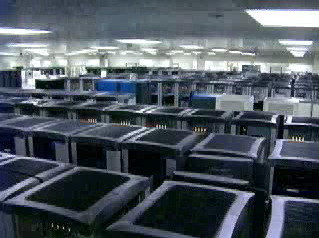
 |
 |
Blue Mountain, once the world’s fastest computer, with the world’s most powerful advanced graphics system has now been superceded by three generations of faster machines. The machine has now been removed from Los Alamos National Laboratory, but its capabilities provide information on the newer supercomputers. Blue Mountain was, in 2003, the latest advancement in the Energy Department’s stockpile stewardship program which uses science-based methods to assess and certify the safety, security and reliability of nuclear weapons without underground nuclear testing. Blue Mountain ran Linpack, one of the computer industry’s standard speed tests for big computers, at a fast 1.6 trillion operations per second (teraOps), giving it a claim to the coveted top spot on the TOP500 list. The Department of Energy is developing five generations of high-performance computers as a part of its stockpile stewardship program with a goal of reaching 100 teraOps by 2004. Blue Mountain is the second of two DOE computers built with a peak speed of at least 3 teraOps. The first, Pacific Blue — developed by IBM was located at DOE’s Lawrence Livermore National Laboratory and has now itself been superceded. |
Plasma science is rich in distinguishable scales ranging from the atomic to the galactic to the meta-galactic, i.e., the {\it mesoscale}. Thus plasma science has an important contribution to make in understanding the connection between microscopic and macroscopic phenomena. Plasma is a system composed of a large number of particles which interact primarily, but not exclusively, through the electromagnetic field. The problem of understanding the linkages and couplings in multi-scale processes is a frontier problem of modern science involving fields as diverse as plasma phenomena in the laboratory to galactic dynamics.
Unlike the first three states of matter, plasma involves the mesoscale and its interdisciplinary founding have drawn upon various subfields of physics including engineering, astronomy, and chemistry. Basic plasma research is now posed to provide, with major developments in instrumentation and large-scale computational resources, fundamental insights into the properties of matter on scales ranging from the atomic to the galactic. In all cases, these are treated as mesoscale systems. Thus, basic plasma research, when applied to the study of astrophysical and space plasmas, recognizes that the behavior of the near-earth plasma environment may depend to some extent on the behavior of the stellar plasma, that may in turn be governed by galactic plasmas. However, unlike laboratory plasmas, astrophysical plasmas will forever be inaccessible to in situ observation. The inability to test concepts and theories of large-scale plasmas leaves only virtual testing as a means to understand the universe. Advances in in computer technology and the capability of performing physics first principles, fully three-dimensional, particle–in–cell simulations, on peta-flop computer frames are making virtual testing a viable alternative to verify our predictions about the far universe.
Copyright - LANS